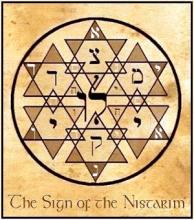One of the great Jewish metaphors is that of the Tzadikim Nistarim, "The Hidden Righteous". It is the concept that, at any given time, there are 36 truly righteous people living in the world. This idea first appeared in the Talmudic tractate of Sanhedrin more than 2000 years ago and has remained a part of Jewish mystical conversations into the modern day. Hidden within the concept of the Tzadikim Nistarim is a thoughtful, somewhat ironic understanding of righteousness and leadership in Jewish philosophy.
The very basic premise of the Tzadikim Nistarim states that, at all times, there are 36 living individuals who embody true righteousness and enlightenment in the world, such that they are suitable representations of the best of humanity. In Christian parlance, they are living saints. When one dies, another immediately rises to take his or her place. There are some conditions to this designation, though. First and foremost, one of the Tzadikim Nistarim would never reveal him or her self to others, if he or she is even aware of the position at all. To do so would be to invite worship, invoke power and indulge in pride, all things that are inherently unrighteous. Conversely, if someone should, by some means, discover one of the Hidden Righteous, it is the first party's responsibility to keep the identity a secret.
Because it would be functionally impossible to actually identify any given generation of Tzadikim Nistarim, we must look to the lessons we can learn from the information we have. Without even supposing these people literally exist, there are many ideas that can be unpacked from the legend. On the very surface, the concept presupposes that human beings are capable of true righteousness, that though sin is an inescapable part of life its existence doesn't preclude the possibility of goodness in people. The Tzadikim Nistarim are not magical or supposed to be more or less blessed than anyone else. In the absence of divine decree, we must assume that the Hidden Righteous are good of their own volition. If a normal person is capable of being among the 36 most righteous people alive, surely everyone else is capable of some fraction of that righteousness.
Even more stirring is the realization that, at least conceptually, everyone is either more or less righteous than the next person. Plainly, if you are less righteous than the Tzadikim Nistarim, perhaps you are more righteous than another person and thus capable of being even more righteous than you are now. By having the nigh-unattainable goal of being as good, modest and thoughtful as the 36 best people alive, you have functionally infinite room to improve yourself. This is a very Jewish philosophy, the idea that goodness knows no bounds and improvement is indeed a life-long mission.
There is also the unmistakable mark of numerology in the Tzadikim Nistarim. It has always been stated that there are 36 of them, 36 being the well-known Jewish number symbol for life itself. Hebrew numbers are represented by letters, so some numbers spell words and vice versa. The Hebrew word "khai" means "life" in the singular and its letters add up to the number 18. Since in Hebrew and in Judaism the concept of life as a whole is stated in the plural, 36 (double life) is the proper representation of the entirety of creation. The connection is clear. The Tzadikim Nistarim exist because of and in service to life itself. Ergo, the origin and purpose of righteousness in Judaism is also life.
Though it sounds almost like the premise of a comic book, the Tzadikim Nistarim, the Hidden Righteous, are a dense, complex lesson about the way Jewish philosophy views the question of goodness. It concludes that righteous behavior is possible for regular people, that it is not meant to acquire power or praise, and its foremost purpose is to better life itself.
